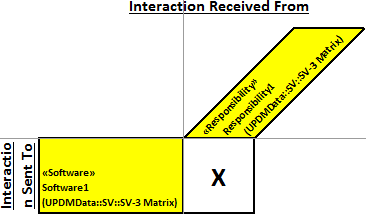SV-3 Resource interaction matrix (UPDM - MODAF aliases)

Creation
To create an SV-3 Resource Interaction Matrix:
• From an
Architectural Description or
Service Description: right-click the element, point to New, point to Matrix/Table, point to MODAF, and then click SV-3 Resource Interaction Matrix.
On the Set the Matrix Type dialog, select the Matrix Type you want to create, either
Command,
Control or
Resource Interaction:
• Select Command, to show the source and target elements for Command elements.
• Select Control, to show the source and target elements for Control elements.
• Select Resource Interaction, to show the source and target elements for Resource Interaction elements.
When you open an SV-3 Resource Interaction Matrix, Modeler can generate it as HTML for viewing in your Internet browser, or generate it as a spreadsheet for viewing in Microsoft Excel. To specify how matrices and tables are opened for a model: in the Packages pane, right-click the Model, point to > > , and then select HyperTextMarkupLanguage_HTML or Excel_XLS.
Each time you open an SV-3 Resource Interaction Matrix, Modeler generates the product using the latest data from the model.
To change the type of an SV-3 Resource Interaction Matrix: right-click the SV-3 Resource Interaction Matrix, point to Set, and then click Matrix Type.
Purpose
On an SV-3 Resource Interaction Matrix:
Elements Shown
An SV-5 Function to Operational Activity/Service Function Traceability Matrix shows the following elements:
• A row is created for each source element of a Command, Control or Resource Interaction (as set for the SV-3 Resource Interaction Matrix) that is found in the analyzed Packages.
In addition, when a target element of a Command, Control or Resource Interaction is found in the analyzed Packages, a row is created for each element that is a source element of that target element.
• A column is created for each target element of a Command, Control or Resource Interaction (as set for the SV-3 Resource Interaction Matrix) that is found in the analyzed Packages.
In addition, when a source element of a Command, Control or Resource Interaction is found in the analyzed Packages, a row is created for each element that is a target element of that source element.
The source and target elements can be as follows:
• For a
Command, the source and destination elements can be
Organization,
Post and
Role Type elements.
• For a
Control, the source element can be an
Organization,
Post or
Role Type, and the target element can be a
Resource Artifact or
Software.
• For a
Resource Interaction, the source and destination elements can be
Capability Configuration,
Organization,
Physical Architecture,
Post,
Resource Artifact,
Role Type,
Service Access and
Software elements.
Analyzed Packages
By default, the SV-3 Resource Interaction Matrix searches for elements that are source or destination elements of Command, Control or Resource Interaction elements (as set for the SV-3 Resource Interaction Matrix) and are contained within the Architectural Description or Service Description that owns the SV-3 Resource Interaction Matrix.
To search for elements from other Architectural Description and Service Description packages: right-click the SV-3 Resource Interaction Matrix, point to Links, and then click Analyzed Packages. On the Links Editor dialog, select the Architectural Description and Service Description packages from which you want to search for elements.
Example
In this example, Architectural Description1 owns SV-3 Resource Interaction Matrix1, Role Type1 and Software1.
SV-3 Resource Interaction Matrix1 is set up to show Resource Interaction relationships.
On an SV-1 Resource Definition, we link Role Type1 to Software1 through a Resource Interaction relationship.

When generated, SV-3 Resource Interaction Matrix1 appears as follows.
 from the matrix you can see that there is an interaction that is received from Role Type1 and sent to Software1
from the matrix you can see that there is an interaction that is received from Role Type1 and sent to Software1The following sections provide information about how an SV-3 Resource Interaction Matrix is used in the model.
Create an SV-3 Resource Interaction Matrix from
Creates or shows these UPDM elements












